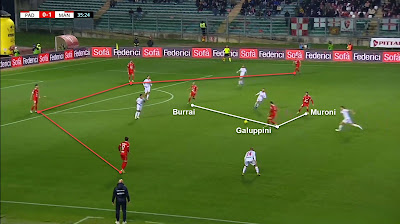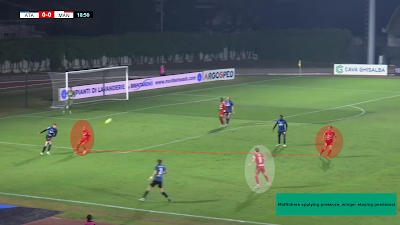We everybody know the style of play promoted by Roberto de Zerbi in his journey from Italy to Ukraine and now to Brighton in Premier League. During this years the Italian manager was supported by many young coaches is his different experiences; those coaches are now manager and they use Roberto de Zerbi vision as a base for their football.
One of them is Davide Possanzini, assistant of De Zerbi at Sassuolo and that is impressing a lot with Mantova, an Italian Serie C team which is now on top of the tournament due to his work. And in this article we are looking at the similarities between the Brighton manager and the current Mantova manager. A similarity which is showing how De Zerbi is creating a coaching tree.
MANTOVA STYLE OF PLAY BY NUMBERS
Before getting deeper in the analysis of the style of play given by Davide Possanzini at Mantova, it is important to show some numbers which provide clear indication on how this style is working.
 |
| Data Source: Wyscout |
The first scatter plot takes in consideration the amount of passes in the opposition third and the ratio of passes in the opposition third compared to the total passes. The second plot takes in consideration the amount of touches in the opponent penalty area and the ratio between the touches in penalty area with the passes in the opponent third.
What we can immediately appreciate is that Mantova (the point in red) is positioned in opposite quadrants in the two diagrams. In the first one the positioning in the left-low quadrant means that the team plays a lot in the own midfield, while the second one shows that once reached the last third Mantova can easily get access to the penalty area.
This is exactly the core of the strategy that Possanzini learnt from his experience as assistant of Roberto de Zerbi. Mantova moves the ball in its own third to attract the opponent pressure and then finding the space to play the ball behind such pressure.
HOW THE STRATEGY WORKS
The template of Mantova with the ball is to overload the build-up and progression zone to attract opponents in its own third. In this example we can see there are six players overloading the zone in which the ball is played, there is also a seventh player out of the image and three players ready to attack the opponent's defensive line. The setup of Mantova when playing the ball, by attracting the opponent is the own third, creates a lot of space in the definition zone, namely the space between midfield and defensive line. This space is the key of Davide Possanzini's strategy: Mantova keeps the ball for long spells in order to create and then explore that space in order to reach as much quickly as possible the penalty area.
The shape durign the build-up phase can be different based on how the opponent is trying to press and how to exploit the opponent half. However, the recurrent pattern is to keep the four defender creating the first line in order to cover the whole width. In this example the defensive line is spread in full width while the two midfielder are staggered: Burrai is the holding midfielder and many possesses of Mantova start from his feet; he his one of the more technical gifted player of the team and for this reason Possanzini gives him the key of the mechanism.
Due to the technical ability of Burrai and also his deep knowledge of the game (he has a lot of experience at Serie B level) as deep-lying midfielder, he his able to choose the right solution to progress play. In this example he attract the pressing from the opponent and exploits the space behind by playing through the thirds or using his technical quality to play long passes reaching the definition zone or the space behind the defensive line. The occupation of the definition zone is usually done by the offensive midfielder Trimboli and the right winger Galuppini who tucks in to occupy the center between the lines and at the same time creating space for the overlaps of the right-back.
In this example, Padova tries to press man-to-man, the concept of the free man is applied by using the goalkeeper Festa that, in this situation of man-to-man is free to play the ball while the movement of the two midfielders Burrai and Muroni manipulate the movement of their assigned opponents by splitting laterally leaving a clear central passing lane for Festa in order to reach again the definition zone, where the possession is accelerated to reach the penalty area.
An other important concept is the proximity between players: when the opponent maintain compactness, Mantova keeps the ball by moving and rotating players creating close passing lane. The key is to create proximity between the players in central zone in order to progress the ball. In this example, the right-winger Galuppini gets deeper to receive the ball from Burrai and acting as third man to reach the other midfildier Muroni. Proximity and third-man are concept which are typical of the De Zerbi style of play that Possanzini clearly learnt to implement in his team.
Here a couple of examples which shows how Mantova attract its opponents on the own third to find the free man behind the pressure and then quickly attack the defensive line.
HOW TO CREATE TRANSITIONS
Part of the vision behind Possanzini's way of play at Mantova is the creation of artificial transitions, meaning situation from an open play where the structure of the opponent team is caught in a situation which generates space and superiority to reach the penalty area.
The main resource used by Possanzini, especially against teams who try to press using a man marking system is finding an open pass lane from the goalkeeper to the central forward Mensah. The Ghanaian player (born in Italy) has scored only two goal but his involvement in Mantova's chances to score is really important. Atalanta U23 is one of the most aggressive team of serie C and in this example is trying to force Mantova to play on the left, however Possanzini (like De Zerbi usually explains) wants to keep progression in the central zone and Mantova is not afraid to use long ball reaching the centre-forward to advance instead of forcing the play through the thirds.
By reaching Mensah, Mantova creates the possibility to attack the opponent's defence through getting the second ball after the duel between Mensah and the opponent's defender. This is probably the part which differentiate Possanzini from De Zerbi ideal way to play (De Zerbi doesn't like to "bet" on second balls) but still keeps the principle to play short in the own half to accelerate in the opponent's half. In this example the two advanced midfielders are running to support the second ball, while the two wingers are ready for two options: supporting Mensah in case the second ball is moved to their side or immediately run into the space behind if the second ball is played on the other side.
Here are some examples on how this system works and how much dangers creates, however it is reliant on the Mensah ability to retain the ball after the duel, and this is the part of Possanzini's play which differs from De Zerbi idea.
THE ATTITUDE WITHOUT THE BALL
 |
| Data source: Wyscout |
How Mantova manages the defensive phase? Numbers say very well. According the data collected from Wyscout until 9 January, Mantova is one of the most aggressive team in serie C based on the challenge intensity index, a team metric, quantifying how many defensive actions (defensive duels, loose ball duels, interceptions, tackles) a team is doing per minute of opponent ball possession. Challenge intensity reflects how often the team is actively trying to recover the ball when the opponent is in possession (thus, it's correlated to PPDA). The higher this number, the more intense the team is in challenges.
In addition to this, Mantova is also good in terms of expected goals conceded per shot, meaning that the defensive strategy of Possanzini team is effective also on a defensive standpoint, even considering that most part of the Mantova's success is also given to the use of ball possession also as an instrument to control the match (68% is the average data of ball possession for Mantova).
The purpose without the ball is to avoid the opponent progressing the field and the strategy generally works with clear indication for the midfielders through a mixed approach: man to man for the central midfielders, positional for the winger. In this example of high pressure the two advanced midfielders Trimboli and Wieser are oriented to Atalanta's players occupying the central zones; the winger Fiori is in a middle position to close vertical passing lane and ready to move to the Atalanta wide man. Behind Fiori the defensive line is supporting the pressure by keeping the line oriented to the ball.
In this situation the defence of the definition and progression zone is still given with the same instructions: the three midfielder in the central zone are oriented to the Atalanta's players trying to progress the ball centrally, in this case the holding midfielder Burrai is deemed to advance to close the opponent central midfielder. Out of the picture Fiori is doing a counter-movement for keeping the positional defence allowing one of the centre-back or the left-back to break the defensive line without losing the structure. Also on the opposite side, the right winger Galuppini is keeping a mid-way position to cover the passing lane in case of switch of play and be ready to support the midfielders in the centre or get back to help the full-back.
Therefore there is a mix between man-to-man approach and positional approach, this is an other strength of the strategy put in place by Possanzini, an approach that is also functional to regain the ball and then being ready to manipulate the spaces creating other situation of transition or artificial transition, thus demonstrating the holistic feature of this strategy as we can appreciate in the following examples.
CONCLUSION
Mantova is one of the most exciting team to analyze in Italy due to the different style of football they are proposing in a tournament like Italian Serie C where it is very difficult to find creative managers.
Possanzini, as said before, is one of the follower of Roberto de Zerbi principles. It is interesting also the fact the the career as manager of De Zerbi started on a professional level in the Italian Serie C when he was the manager of Foggia.
De Zerbi in that spell in Foggia was not able to win the tournament (he lost the playoff final against Gattuso's Pisa in 2016), while Possanzini is on top of group A of serie C seven point clear of second classified Padova. This was something unexpected since Mantova last year was relegated from serie C and is now playing this tournament cause they obtained a repechage due to financial issues of other teams excluded from serie C in this year. Through the acquisition of a couple of good player (in particular the holding midfielder Burrai) surrounded by interesting young prospect (for example the winger Fiori or the midfielder Trimboli, respectively born in 2003 and 2002) Possanzini was able to implement his strategy at its best.
















No comments:
Post a Comment